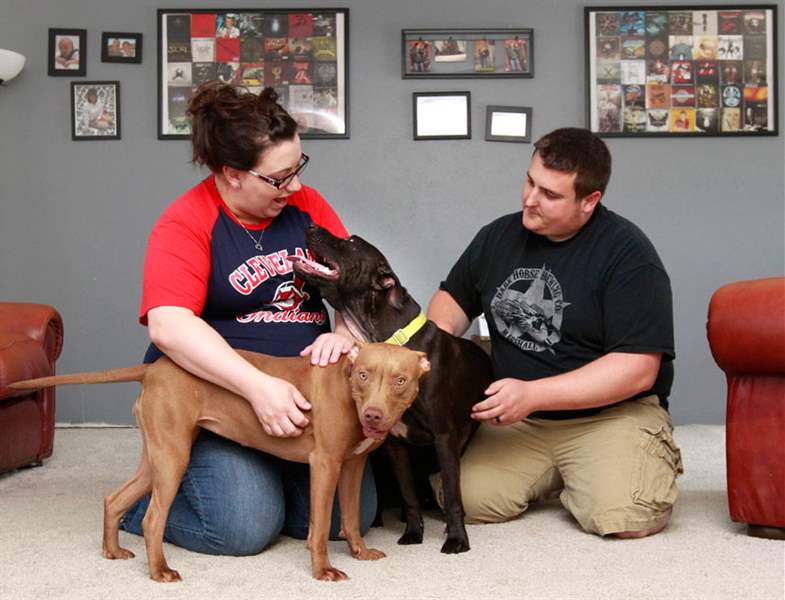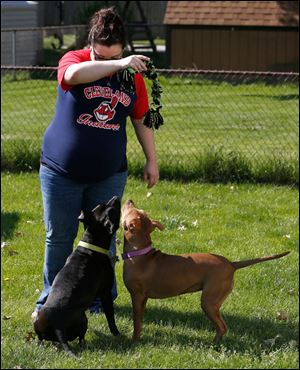
‘Pit bulls’ fate improves, kill rate drops sharply
More being reclaimed by owners, adopted out
6/2/2014
Amanda and Nathan Overholt of Northwood adopted two ‘pit bulls’ — Ginger, left, and Ace — from the Lucas County Pit Crew in the last year. The advocacy organization recently adopted out its 50th ‘pit bull.’
The Blade/Lori King
Buy This Image

Amanda and Nathan Overholt of Northwood adopted two ‘pit bulls’ — Ginger, left, and Ace — from the Lucas County Pit Crew in the last year. The advocacy organization recently adopted out its 50th ‘pit bull.’
Area dog advocates say the plight of “pit-bull”-type dogs in Lucas County has greatly improved over the last few years, but more progress is needed.
“It’s very encouraging where things are now, as compared to where they were before,” said Jean Keating, executive director of the Lucas County Pit Crew and co-founder of the Ohio Coalition of Dog Advocates. “We’re moving in the right direction.”
In 2012, Ohio altered a 25-year-old law that deemed all “pit bull”-type dogs as inherently vicious, resulting in the deaths of thousands of canines each year. The new law removed the breed designation and focused instead on dogs’ behavior in determining whether they are dangerous.
“Public perception and attitude toward pit bulls has evolved,” Julie Lyle, director of Lucas County Canine Care & Control, said. “They’re showing less fear of them and being more open to looking at these dogs as pets.”
“Pit bulls” are popular dogs for a variety of reasons, both good and bad. Cindy Reinsel, director of Toledo’s PET Bull Project, said the dogs are sought after both as companions and for more sinister purposes like dog-fighting.
RELATED CONTENT: Proposed law would demand ‘vicious’ dogs be put to death
PHOTO GALLERY: Plight of ‘pit-bull’-type dogs
“You have the people who are doing the wrong thing with them, and you have the people that love them and are advocates for the breed,” she said. “People are in love with them overall right now.”
Their popularity means that many of them wind up at the county dog shelter. In 2004, the shelter took in 857 canines, about 21 percent of the total number of dogs that year, identified as “pit bull”-type dogs. Last year, “pit bull”-type dogs numbered 1,149, representing about 32 percent of all dogs brought to the shelter. The 2013 statistics do not include January and February because of the county shelter’s switch to computerized records.
As of early last week, the county had taken in 528 “pit bulls,” a figure that amounts to about 39 percent of the total 1,344 dogs taken in so far this year.
Ms. Lyle said while many of the shelter’s “pit bulls” come in as strays, there’s no way to know where the dogs are coming from.
“It’s just the population of dogs we have in our county,” she said. “There are more ‘pit bulls’ out there breeding, and we have a lot of ‘pit bull’ mixes.”
Before the law changed, nearly all dogs identified as “pit bulls” were killed at the shelter. From March to December, 2013, 714 “pit bulls,” about 62 percent, were killed. The remaining 435, about 38 percent, were claimed by owners, adopted, or transferred to area rescues.

Amanda Overholt plays with her ‘pit bulls,’ Ace, left, and Ginger in the backyard of her Northwood home. She said she was skeptical of the breed until she met Ace.
So far this year, more than half — 276, or about 52 percent — have been reclaimed by their owners, adopted out, or transferred. About 48 percent, or 252, have been killed.
Ms. Keating said while great strides have been made in recent years in recognizing “pit bulls” as dogs like any other, the label — and the negative stigma that often accompanies it — remains problematic.
“Every mixed-breed dog with short hair and a big head is a ‘pit bull’ in this county,” she said. “It’s gotten better than in years past, but I still think we way over-identify them. A lot of these dogs are just mixed-breed dogs. They’re a hodge-podge of things.”
“Pit bulls” aren’t a specific breed, but rather a generalization of a group of breeds like the American pit bull terrier, American Staffordshire terrier, and Staffordshire bull terrier. Some people also lump in so-called “bully breeds” like bulldogs into the “pit bull” label.
Ms. Lyle includes American bulldogs in her classification as “pit bull”-type dogs.
“If their predominant look appears to be ‘pit bull,’ that’s how we classify them,” she said.
Ms. Keating said visual identification of mixed-breed dogs is very inaccurate, and a few shelters in the United States have done away with breed labels for that reason. Many breeds can give dogs a “pit bull” look with large, squarish heads and broad chests. She listed off boxers, Labrador retrievers, and Rottweilers as examples, and said DNA breed testing of dogs labeled as “pit bulls” often reveals little or no actual “pit bull.”
“If you’re going to label them, it’s better to do that by their energy level or their age or something like that,” she said. “They’re all just dogs.”
She said her group has had increasing success with “pit-bull” adoptions, and it celebrated its 50th such adoption this year. In all, the group has adopted out 219 dogs since they first launched their rescue.
Amanda and Nathan Overholt of Northwood have adopted two “pit bulls” from Ms. Keating’s group in the last year.
“I was skeptical of the breed before we met our first dog, Ace,” Mrs. Overholt said.
“We happened to see his profile on a Web site, and we didn’t realize he was a pit bull before we met him. But as soon as we saw him, we fell in love.”
With a baby on the way, Mrs. Overholt said, some friends have expressed surprise at her choice of dog. But, she said, he’s “a total ham” — everyone in the community has come to love him and his canine compatriot.
Toledo’s PET Bull Project frequently holds dog education classes in area corrections and treatment centers, and often works in the city’s rougher neighborhoods. Mrs. Reinsel said many people the organization comes across who are scared of “pit bulls” are even more so now than in past years because of the dogs’ higher population numbers.
“It has been exacerbated because there are so many more of them running around as strays,” she said. “We have a lot more backyard breeding going on, and a lot more dog fighting.”
The nonprofit works with all ages, but has recently been targeting the city’s youth much more.
“We try to educate everyone we come across, but if we can get to the younger kids and give them more information and teach them, they are more likely to think about what we said the next time they see a ‘pit bull,’ ” Mrs. Reinsel said.
Staff writer Jennifer Gersten contributed to this report.
Contact Alexandra Mester: amester@theblade.com, 419-724-6066, or on Twitter @AlexMesterBlade.